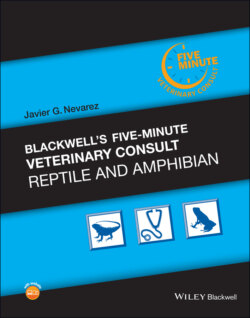Читать книгу Blackwell's Five-Minute Veterinary Consult: Reptile and Amphibian - Javier G. Nevarez - Страница 47
Anatomy and Physiology of Amphibians
ОглавлениеAmphibians are a group of vertebrates with significant conservation challenges. They have a worldwide distribution, but most species occur in tropical climates. There are over 8,000 amphibian species distributed among three orders: Anura, Cuadata, and Gymnophiona.
The order Anura includes frogs and toads and comprises the majority of amphibians with over 7,100 known species. In general terms, frogs live in or near water while toads are more terrestrial. As such, frogs have thinner more permeable skin while toads have thicker skin to protect against dehydration. The vast majority of anurans are oviparous but a few ovoviviparous to viviparous species exist.
The order Caudata includes salamanders and newts, with over 700 species. Salamanders are primarily terrestrial while newts are aquatic to semiaquatic. Sirens and amphiumas are primarily aquatic. Amphibians in this order are mostly oviparous and are capable of neoteny, which is the retention of juvenile characteristics in fully mature animal. As such, neotenic amphibians can reproduce despite the retention of juvenile features like gills. There are three types of neoteny described—obligate, inducible, and facultative. Obligate neotenic species are not able to metamorphose either in nature or through experimental stimulation. The families Amphiumidae (amphiumas), Sirenidae (sirens), Proteidae (mudpuppies, waterdogs, European blind cave salamander), and Cryptobranchidae (giant salamanders) are all known to express obligate neoteny. Inducible obligate neotenic species do not metamorphose in nature but can be induced to metamorphose through the administration of thyroxine or thyroid‐stimulating hormone. Perhaps the best‐known neotenic species, the axolotl (Ambystoma mexicanum) is an inducible obligate neotenic species, although many specimens are reported to have a shorter lifespan after metamorphosis. Some members of the family Plethodontidae (lungless salamanders) are also inducible obligate neotenic species. Metamorphosis in the facultative neotenic species occurs according to environmental conditions, most commonly associated with the lack of development of the thyroid gland. Facultative neotenic species can be found in the families Ambystomatidae, Salamandridae (true salamanders, newts), and Hynobiidae (Asiatic salamanders). The tiger salamander (Ambystoma tigrinum) is the best‐known facultative neotenic species.
The order Gymnophiona includes caecilians, which are a lesser known and studied group with over 200 species. Caecilians resemble earthworms and have reduced or absent eyes and limbs. There are both aquatic and terrestrial species that are mostly found in tropical lowlands. New world species are primarily viviparous while those from the old‐world are oviparous.
